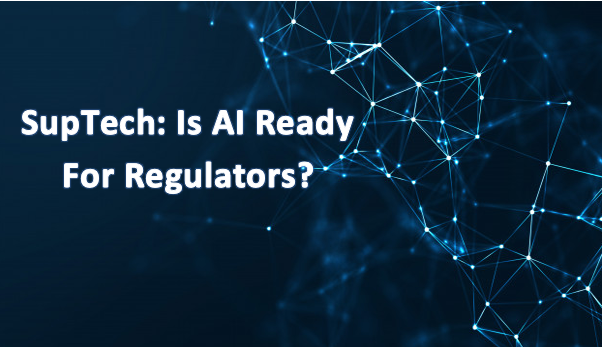SupTech: Is AI Ready For Regulators?
Technology advancements in ML, AI and Big Data has led to further enhancement of supervisory processes, introducing SupTech. But is it the right time to embrace it and is it ready for adoption? Read more to understand the benefits of AI in SupTech and how it can streamline regulations for the industry.
While financial institutions are embracing new technology innovations in the FinTech / RegTech space, 2019 is seeing the emergence of Supervisory Technology (SupTech). SupTech is maturing to ensure more robust safeguards and frameworks for enabling advancements in technology like Artificial Intelligence (AI) and Machine Learning (ML) to be used for regulatory supervision.
SupTech: Why Is It Necessary?
Supervisory Technology or SupTech encompass technology innovation designed to tackle challenges faced by supervisory agencies. SupTech is focused on automating and streamlining administrative and operational procedures, digitizing data and improving data analytics for regulators.[1]
Enabling SupTech can actually complement RegTech to create a more robust and streamlined compliance and risk framework for the industry. The efficiencies that these technology offers can be harnessed in support of compliance within financial regulation (RegTech) and conduction of financial supervision (SupTech). RegTech refers to the applications of the innovative technologies that support compliance, whereas, SupTech refers to the technologies used by the supervisory agencies themselves.
SupTech offers an opportunity for supervisory agencies to enable efficient reporting process and proactive monitoring for faster and better regulatory insights.
Risk And Challenges Faced By Regulators
The potential risks and challenges faced by regulators are:[2]
- Data Collection & Management: The most important step in transforming financial institution is improvising data management and collection. Currently, the approach to data collection by the regulatory authorities is periodically collecting the data in the standard reporting templates. While financial institutions are burdened in this process, analyzing the data once received is costly and time consuming for both institutions and regulators.
- Digital Transitions: Since the financial crisis, regulators have been demanding much more data and other requirements from institutions. With the current regulatory framework, regulators have to manage large inflow and volumes of data. Therefore, regulators must migrate to a digital based supervisory process to cope with the high volume of data they receive.
- Realtime Access: The current AML / fraud detection and mitigation process is more reactionary than proactive, meaning the violation has already taken place by the time the regulators and the concerned institutions are notified. This could at times be months after the crime has occurred, meaning the damage is done and noncompliance fines almost certain. SupTech can enable real-time monitoring to prevent a wide array of financial crimes and notify authorities to mitigate it with improved accuracy.
SupTech: Benefits & Opportunities
Technology advancements in ML, AI and Big Data has led to further enhancement of supervisory processes. SupTech has gained significant attention and momentum due to the use of technology to adapt, develop and enhance supervisory controls across all the forms of reporting sectors into a single platform.
The greatest benefit for introducing the SupTech for regulatory bodies is the ease in making determinations after implementing data-intensive case management tools. Whereas the work of analysts typically takes months, sometimes years to manually analyze the data (both qualitative and quantitative), SupTech can provide all relevant data within minutes to enable a human determination. This assists government supervisory bodies who have obstacles such as:
- AML/Fraud: The agency has several high priority portfolios and might not always treat AML/ Fraud with the priority that it needs
- Data From Disparate Sources: Data received has no consistency in the data gathered
- Human Competency: The supervisory authority face resource constraints and depend heavily on the competency of a few resources
Suptech can automate and consolidate regulatory processes like:
- Data Collection: SupTech applications are used in reporting, data management and virtual assistance. Currently, institutions send the transaction data history in different reporting formats which results in the heavy process of data analyzing and data gathering.
- Data Analytics: SupTech streamlines data collection and data analytics. By helping supervisory agencies, reporting processes are made more efficient. Reports from the bank are standardized ensuring there are no gaps in the reporting process from bank to bank, resulting in reduced costs and time it takes to analyze data. This allows supervisors to spot violations earlier and better monitor potential forbidden activity.
Various Areas Of Financial Supervision In Which SupTech Applications Are Used:

Image From: FSI Insights: Innovative technology in financial supervision (SupTech) – the experience of early users
With the emergence of SupTech, it is now possible for the supervisory agencies such as capital markets, central banks, and banking authorities to utilize internal data and external data records to better monitor financial markets using AI.
SupTech: Making Regulatory Processes Effective & Efficient
AI offers the opportunity to improve the efficiency and effectiveness of market conduct supervision by turning compliance and risk monitoring from a backwards-looking process into a powerful, real-time predictive and proactive process.
The power of AI in SupTech can be leveraged to automate and consolidate inefficient and ineffective processes in Regulatory Compliance, Reporting, Risk Management and Monitoring. Meanwhile, cloud systems enable the secure distribution of information across multiple regulators. Predictive analytics and automation can leverage AI to extend the reach of regulators and make regulatory compliance simple, smart and efficient.
SupTech potentially changes the dynamics between regulators and financial institutions. It delivers consistency and allows reporting of granular data faster while bringing about evidence-informed policies and regulatory approaches that are responsive to market changes.
In summary, SupTech gives regulators access to data real-time and the ability to make quicker decisions, resulting in more meaningful outcomes not just for the regulators but financial institutions in general.
Contributor:
References:
[1] https://res.torontocentre.org/guidedocs/FinTech%20RegTech%20and%20SupTech%20-%20What%20They%20Mean%20for%20Financial%20Supervision.pdf
[2] https://www.finextra.com/blogposting/15556/the-big-bang-of-FinTech–RegTech-and-SupTech



